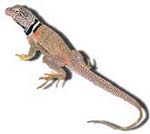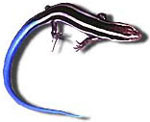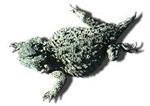Order:
Squamata
Lacertilia:
(Lizards)
The following
taxonomic list will link you to the individual species.
Characteristics that distinguish
Idaho Lacertilia from the group Serpentes are the presence of four limbs (there
are some lizards species elsewhere that lack limbs), visible ear openings, and
movable eyelids. These three characters alone should allow you to readily recognize
Idaho lacertilians.
Family:
Anguidae
(Anguids)
|
The family Anguidae is comprised of 15 genera and around
102 species (Pough et al. 1998). They are mainly distributed
in separated regions of North, Central and South America, and portions
of Africa and Asia (Goin and Goin 1971, Pough et al. 1998).
Several species of lizards in this family have reduced or absent limbs
and both oviparous and viviparous
and viviparous reproductive modes are present, sometimes within the same genus.
In fact, the Idaho representative, Elgaria coerulea (Northern
Alligator Lizard) is viviparous giving live birth, while the Southern
Alligator Lizard (Elgaria multicarinata) is oviparous.
reproductive modes are present, sometimes within the same genus.
In fact, the Idaho representative, Elgaria coerulea (Northern
Alligator Lizard) is viviparous giving live birth, while the Southern
Alligator Lizard (Elgaria multicarinata) is oviparous.
|
|
|
|
|
|
Family:
Crotaphytidae
(Crotaphytids)
|
The family Crotaphytidae is comprised of 2 genera and
12 species, and they are found in North and Central America (Pough et
al. 1998). The lizards in this family are moderately sized and
occupy mesic or arid regions. An interesting characteristic is
that the lizards in this family include other vertebrates in their diet.
In Idaho, both the Longnose Leopard Lizard (Gambelia wislizenii)
and the Mojave Black-collared Lizard (Crotaphytus bicinctores)
eat other lizards.
|
 |
 |
|
|
|
Family:
Phrynosomatidae
(Phrynosomatids)
Family:
Scincidae
(Skinks)
The family
Scincidae is a diverse and cosmopolitan family consisting of approximately
100 genera and about 1090 species (Pough et al. 1998). Skinks in
general are characterized by smooth cycloid
scales ,
a well developed secondary palate, osteoderms ,
a well developed secondary palate, osteoderms (bony elements in the skin) that are comprised of many small bones, and
limb reduction in several species.The only representative of this family
in Idaho is the Western Skink (Eumeces skiltonianus).
(bony elements in the skin) that are comprised of many small bones, and
limb reduction in several species.The only representative of this family
in Idaho is the Western Skink (Eumeces skiltonianus).
|
 |
|
|
Family:
Teiidae
(Teids)
|
The family Teiidae is comprised of 40 genera (including both macro
and microteiids, which are sometimes considered separate families)
and around 245 species (again for both macro and microteiids) that
range from North, Central, and South America (Pough et al. 1998).
The Western Whiptail (Cnemidophorus tigris) is the only species
of the family Teiidae. Lizards in this family are found in
a wide range of habitats and have a wide range of body forms.
All Teiids have forked snake-like tongues, and several different
species have parthenogenic reproduction (Pough et al. 1998).
reproduction (Pough et al. 1998).
|
|
|
|
| |
Author: John
Cossel Jr.© 1997
Design and Optimization by Ean Harker©1999, 2000.
Adaptation for DAI by Stephen Burton, and Mike Legler ©1999.
Original images provided by Charles R. Peterson and John Cossel Jr.©1998.









